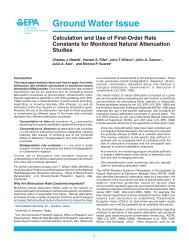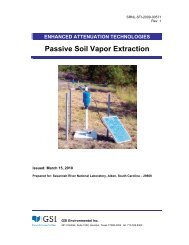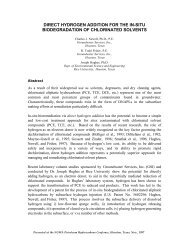Indoor Air as a Source of VOC Contamination in Shallow Soils - GSI ...
Indoor Air as a Source of VOC Contamination in Shallow Soils - GSI ...
Indoor Air as a Source of VOC Contamination in Shallow Soils - GSI ...
You also want an ePaper? Increase the reach of your titles
YUMPU automatically turns print PDFs into web optimized ePapers that Google loves.
116 T. E. McHugh et al.positive pressure conditions occurred more than 30% <strong>of</strong> the time, subsurface <strong>VOC</strong> concentrationsexceeded <strong>in</strong>door <strong>VOC</strong> concentrations for at le<strong>as</strong>t 50% <strong>of</strong> the 5-day simulationperiod.In addition to the pressure <strong>as</strong>sumptions described above, other model <strong>in</strong>put parameterscan significantly affect the results. A lower below-foundation soil permeability greatly<strong>in</strong>cre<strong>as</strong>es the persistence <strong>of</strong> <strong>VOC</strong>s <strong>in</strong> the subsurface follow<strong>in</strong>g removal <strong>of</strong> the <strong>in</strong>door <strong>VOC</strong>source. For example, a soil permeability representative <strong>of</strong> a f<strong>in</strong>e-gra<strong>in</strong>ed sand (i.e., 1 ×10 −12 m 2 ) results <strong>in</strong> the presence <strong>of</strong> detectable <strong>VOC</strong> concentrations <strong>in</strong> the subsurface formore than 30 days follow<strong>in</strong>g the rele<strong>as</strong>e <strong>of</strong> a transient <strong>in</strong>door <strong>VOC</strong> source. In contr<strong>as</strong>t,although not considered <strong>in</strong> the model, w<strong>in</strong>d-driven advection <strong>of</strong> outdoor air through thebelow-foundation soils (Fischer et al., 1996) could serve to reduce the magnitude andduration <strong>of</strong> subsurface <strong>VOC</strong> impacts from <strong>in</strong>door sources.The sensitivity analysis <strong>in</strong>dicates that the advection model presented here providesqualitatively similar results over a broad range <strong>of</strong> build<strong>in</strong>g pressure conditions. However,the quantitative model results vary significantly depend<strong>in</strong>g on the selection <strong>of</strong> model <strong>in</strong>putparameters. As a result, the model should be considered a qualitative tool for the evaluation<strong>of</strong> potential <strong>VOC</strong> exchange between a build<strong>in</strong>g <strong>in</strong>terior and the subsurface. <strong>Indoor</strong> <strong>VOC</strong>sources <strong>of</strong> higher m<strong>as</strong>s flux or longer duration result <strong>in</strong> higher below-foundation <strong>VOC</strong>concentrations. The specific model results presented for the b<strong>as</strong>e c<strong>as</strong>e scenarios are <strong>in</strong>tendedto illustrate the types <strong>of</strong> <strong>VOC</strong> concentration gradients that may be observed between <strong>in</strong>doorair and subsurface vapors follow<strong>in</strong>g the rele<strong>as</strong>e <strong>of</strong> a transient <strong>in</strong>door <strong>VOC</strong> source. Theresults are not <strong>in</strong>tended to quantify the magnitude or duration <strong>of</strong> these relationships <strong>in</strong>specific build<strong>in</strong>gs.Field Evaluation <strong>of</strong> Below-Foundation <strong>VOC</strong> ImpactsIndependent <strong>of</strong> model simulations, field me<strong>as</strong>urements <strong>of</strong> <strong>in</strong>door and below-foundation<strong>VOC</strong> concentrations have also <strong>in</strong>dicated the migration <strong>of</strong> <strong>VOC</strong>s from <strong>in</strong>door air <strong>in</strong>to thesubsurface. <strong>Indoor</strong> air and below-foundation samples collected from three apartments ata complex <strong>in</strong> Fort Worth, Tex<strong>as</strong>, show that <strong>VOC</strong>s orig<strong>in</strong>at<strong>in</strong>g <strong>in</strong>doors have migrated <strong>in</strong>tothe subsurface and are present at detectable concentrations. Although this is a limited dat<strong>as</strong>et from a s<strong>in</strong>gle site, the results provide a prelim<strong>in</strong>ary <strong>in</strong>dication that <strong>VOC</strong> transport from<strong>in</strong>door to the subsurface can occur.Sample Collection and AnalysisAn <strong>in</strong>door air and below-foundation vapor sampl<strong>in</strong>g program w<strong>as</strong> conducted <strong>in</strong> three vacantapartments with<strong>in</strong> an apartment complex <strong>in</strong> Forth Worth, Tex<strong>as</strong>. The <strong>in</strong>itial purpose <strong>of</strong> thesampl<strong>in</strong>g program w<strong>as</strong> to evaluate the potential for vapor <strong>in</strong>trusion impacts <strong>as</strong>sociated withmethyl-tertiary butyl ether (MTBE) detected <strong>in</strong> a groundwater monitor<strong>in</strong>g well upgradient<strong>of</strong> the property at an adjacent former g<strong>as</strong> station. Groundwater samples from the adjacentproperty have been analyzed for benzene (16 to 4,800 ug/L), ethylbenzene (3 to 490 ug/L),toluene (






